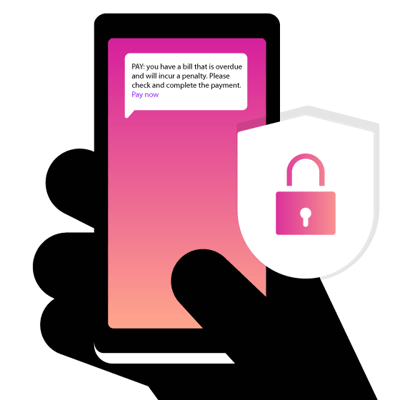Two-Factor Authentication: How It Works, When to Use It, and Other FAQs
With cybercriminals continually updating their methods, it's critical for your business to persistently update data security — starting with a user verification process that looks beyond passwords. Let's look at some typical questions raised about two-factor authentication.
What Is Two-Factor Authentication?
Two-factor authentication (2FA) is an electronic verification process that requires users to verify their identity in two ways before they can access protected data on your website or mobile application. Usually, the first factor is a password or passcode that they must know, while the second is something the user must possess.
Passwords have long been the standard for account verification. But while hackers have gotten smarter and more creative, password users have not. There are currently 24 billion login credentials available for purchase on the dark web, according to threat intelligence firm Digital Shadows. And of the 50 most common passwords, 49 can be cracked in less than one second using cheap, easy-to-find hacking tools.
Two-factor authentication adds an extra layer of security so that even if a hacker knows a user's login credentials, they can't verify their identity without that second factor.
What Are the Different Types of 2FA?
Common 2FA authentication methods include:
Knowledge. Something you can readily recall, such as a password, PIN, or answers to personal questions (e.g., your childhood best friend's name or the first car you drove).
Possession. Something you have with you, such as a smartphone, ID or credit card, or hardware token.
Inherent biometrics. Something that is part of you, such as your fingerprints, face, eyes, or voice.
Location. Where you are, based on your IP address or GPS location.
How Does 2FA Work With Websites and Apps?
The process depends on which factors are required to log in, but a common combination is a password and a one-time code. The code is usually a randomly generated set of numbers or characters sent to the user's mobile phone or another device that's only valid for a limited time. The process often goes like this:
The user begins the login by entering their username and password.
When the server recognizes the user and account, it uses software like the Vonage Verify API to generate a code and send it to the email or phone number on the account records.
The user receives the code via phone call, SMS, email, or other route.
The user enters this second piece of information on the login page.
Once the two factors are verified, the user is granted access to the website or app.
 Fight messaging fraud with Vonage Fraud Defender
Fight messaging fraud with Vonage Fraud Defender
Why Isn't a Password Enough Protection?
Passwords are vulnerable to a variety of cyberattacks, from phishing and formjacking to malware such as password dumpers to large-scale ransomware attacks. Criminals often just buy the information other hackers have gathered. The Dark Shadows study found that the number of account login credentials for sale online has increased 65% over the past two years. Yet most people still use easy-to-guess passwords (like "password") and reuse passwords across accounts. That means information stolen in another company's data breach could be used to access your database if the same customer used the same password for both.
What Threats Does 2FA Prevent?
Two-factor authentication helps protect your users against fraud and your business from experiencing data breaches, which have been on the rise for years. So have the associated costs. In 2022, the average data breach cost companies $4.35 million, up nearly 13% since 2020. Nearly one in five data breaches involved stolen or compromised login credentials, and another 16% resulted from phishing schemes in which hackers tricked people into sharing personal information or installing malware.
If you work in a highly regulated industry, such as healthcare or finance, data breaches can be even more expensive and consequential. Online portals that grant information to protected health or financial data must be heavily protected to comply with industry-wide data privacy laws.
How Secure Is 2FA?
The more layers of identity verification that you add, the harder you make it for cybercriminals to access your users' accounts. Even two-factor authentication can greatly reduce data breaches. For example, Google began rolling out 2FA to its users earlier this year. More than 150 million accounts now require 2FA, which has resulted in a 50% decrease in compromised Google accounts.
Why Do You Need 2FA?
With data breaches on the rise across industries, companies of all sizes must batten down the hatches to protect the information their customers trust them to keep safe and private. This requires a variety of critical cybersecurity tools and measures, starting with strengthening customer portals.
Two-factor authentication adds an additional layer of data protection to the login process without making it overly complicated or frustrating. It's one more step for users, but at the same time they know your company is taking cybersecurity seriously, which can improve the customer experience. They know they can trust you with their data, and that's a good reputation to have.
What Is Multi-Factor Authentication?
Multi-factor authentication (MFA) requires users to verify their identity in more than one way — using a bigger combination of knowledge, possession, inherent biometrics, and location factors. For true MFA, your system must require at least two different types of factors. For example, if users are only asked to enter a password and answer a secret question, that's a single-factor authentication process because both of those are knowledge factors.
What Is the Difference Between 2FA and MFA?
MFA means two or more factors, while 2FA means exactly two.
Is It Complicated to Set Up a 2FA Solution?
The Vonage Verify API provides a robust 2FA solution without requiring users to have any special hardware or authenticator apps. In addition, you only pay for successful verifications.
Don’t wait for the next cyberattack before you act. Learn more about Vonage Verify API today, or take a deep dive into the newest version.
